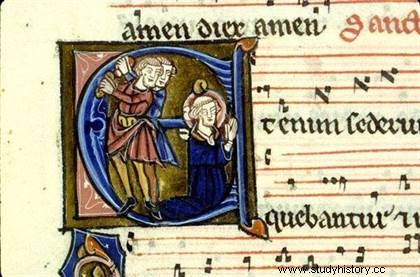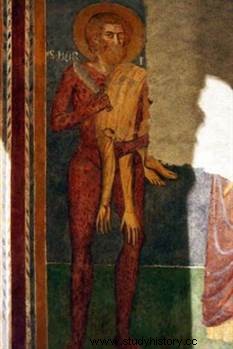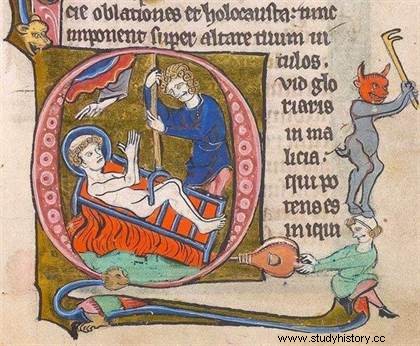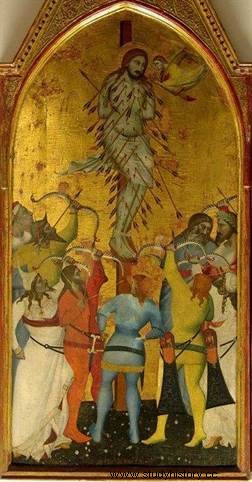 The medieval world is also – and above all – a universe made up of images that must catch the eye of passers-by. In these societies where religion constitutes the cement of mentalities, iconography is there so that everyone can see and understand the world. Thus, each element, each physical trait, has a particular meaning. The death of saints and martyrs is therefore represented in a violent way, in order to impress the faithful and remind them of the cruelty of the persecutions committed by “pagans” or Jews. Through these few representations, produced between the 13th and 14th centuries, we will see how these violent deaths are staged.
The medieval world is also – and above all – a universe made up of images that must catch the eye of passers-by. In these societies where religion constitutes the cement of mentalities, iconography is there so that everyone can see and understand the world. Thus, each element, each physical trait, has a particular meaning. The death of saints and martyrs is therefore represented in a violent way, in order to impress the faithful and remind them of the cruelty of the persecutions committed by “pagans” or Jews. Through these few representations, produced between the 13th and 14th centuries, we will see how these violent deaths are staged.
Saint Stephen (I):death by stoning
Etienne, accused of having uttered blasphemous words against Moses and God, is brought to justice before an assembly of Jews gathered at the Sanhedrin. The future Saint then claims to contemplate “the open heavens and the Son of Man standing at the right hand of God”. His accusers, exasperated, push him out of the city, knock him down and stone him.
 This scene is common in medieval iconography. We can see Etienne, young in appearance, kneeling with his hands joined, his head haloed. The Saint is then clothed with the dalmatic of the deacon, sometimes holding in his hand, the object of his martyrdom.
This scene is common in medieval iconography. We can see Etienne, young in appearance, kneeling with his hands joined, his head haloed. The Saint is then clothed with the dalmatic of the deacon, sometimes holding in his hand, the object of his martyrdom.
Thereafter, he became the patron saint of soldiers armed with a slingshot, masons, stonemasons and all trades related to stone.
Saint Barthélémy (I):skinning
Bartholomew is said to be the one who evangelized Arabia and then Mesopotamia. He first goes to Armenia before arriving in India. Jacques de Voraigne in his Golden Legend (13th century) gives a precise physical description of him "black and frizzy hair, white flesh, large eyes, equal and well-opened nostrils, thick beard with a few white hairs, average stature" . At the age of twenty-six, he was preaching in India when the brother of King Polème, Astiage, had him arrested in order to make him renounce his faith. Barthélémy refuses and is flayed alive then crucified upside down.
In fact, the Saint is represented flayed, carrying his skin on his shoulder or holding it in his arms. Often, he is depicted undergoing his ordeal. The painters of the Baroque age will later make the scene even more morbid.
Barthélémy became the protector of the trades of butchers, tanners, furriers, tailors and more generally of those who handled hides. Later his name will be taken up in the context of the massacres of Saint Barthélémy.
Saint Laurent (3rd):fire
Originally from Huesca in Aragon, Laurent was the deacon of Pope Sixtus II. His martyrdom is dated precisely in 258. The generosity with which he dispenses his alms attracts the wrath of the Emperor Valerian who tries to recover the wealth of the Church. Laurent is then arrested and executed. Legend has it that he was brought to the grill and, before he died, addressed Valerian saying "I'm roasted on this side, turn me to the other side and eat me". Saint Laurent was frequently associated with Vincent de Zaragoza, hence the iconographic confusion about him.
 He is usually represented wearing the dalmatic or even posed on a grill where executioners and demons stir up burning embers fire using large bellows.
He is usually represented wearing the dalmatic or even posed on a grill where executioners and demons stir up burning embers fire using large bellows.
By his ordeal, he became the patron saint of roasters, cooks, glassmakers or more simply the poor in reference to his large alms.
Saint Denis (III):the ax
At the end of the 3rd century, Denis – converted by Saint Paul – left Athens to reach Paris and then became the first bishop of the city. His sermons attract the wrath of the emperor, who then has him arrested and inflicts many tortures on him, then beheads him. A miracle ensues. Saint Denis gets up, grabs his head and goes alone to the place of his burial. In 659, Dagobert had the relics of the Saint transported to the Saint Denis church which gradually became the royal necropolis.
In medieval iconography, Denis is most often depicted standing, holding his head in his hands. He is also recognizable thanks to his bishop's miter and sometimes his chains.
After Dagobert and during the Middle Ages, Saint Denis became the protector of the Kingdom of France.
The death of Saint Sebastian (3rd-4th):the arrows
Commander of Diocletian's Praetorian Guard, Sebastian is arrested for proselytizing. He was subsequently sentenced to death. According to tradition, two soldiers pierce him with arrows. However, this first martyr fails to kill him. Sebastian goes to the emperor to reaffirm his faith. Diocletian then had him stoned and then threw his body into the Cloaca Maxima. The Saint appears in a dream to a matron who finds his body and buries it in the catacombs.
In iconography, there are already paintings of the Saint on the walls of the catacombs of Callistus in Rome from the fifth century. Saint Sebastian is represented in various forms. However, he is frequently riddled with arrows, tied to a post. The painters of the Italian Renaissance will give him the features of a handsome young man assimilated to an Apollo.
Thereafter, he became the protector of athletes, archers and upholsterers.
Bibliography
- Gaston DUCHET-SUCHAUX and Michel PASTOUREAU, The Bible and the Saints, Flammarion, September 2014.
- Rosa GIORGI, The Saints, Hazan, 2009.

